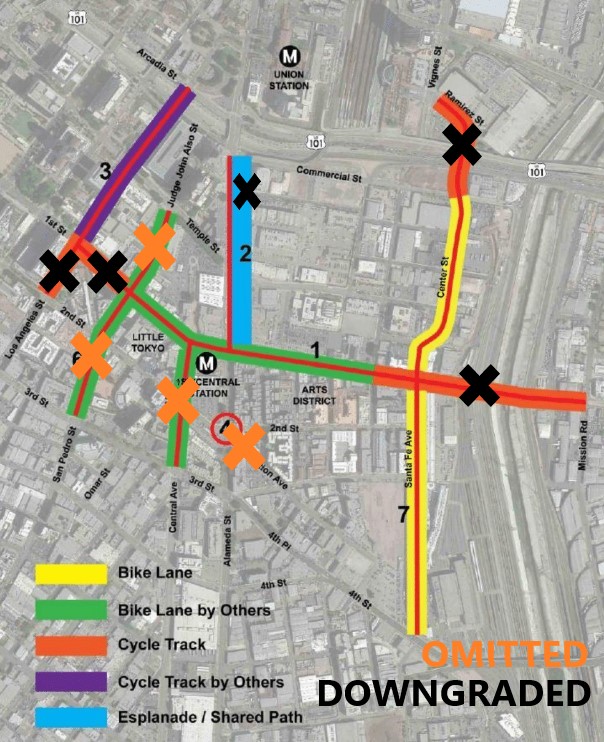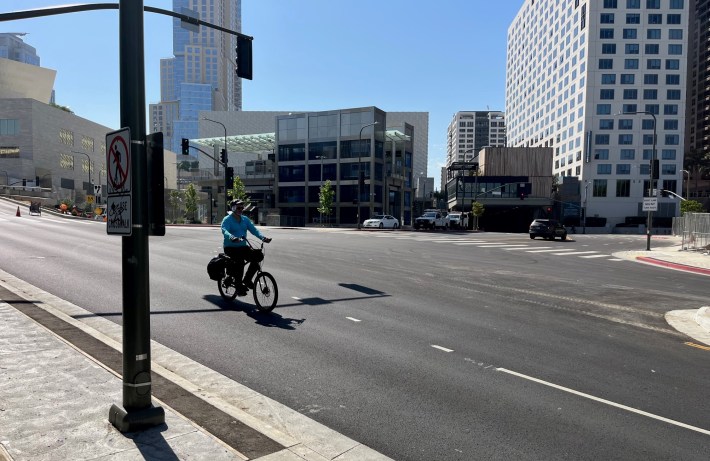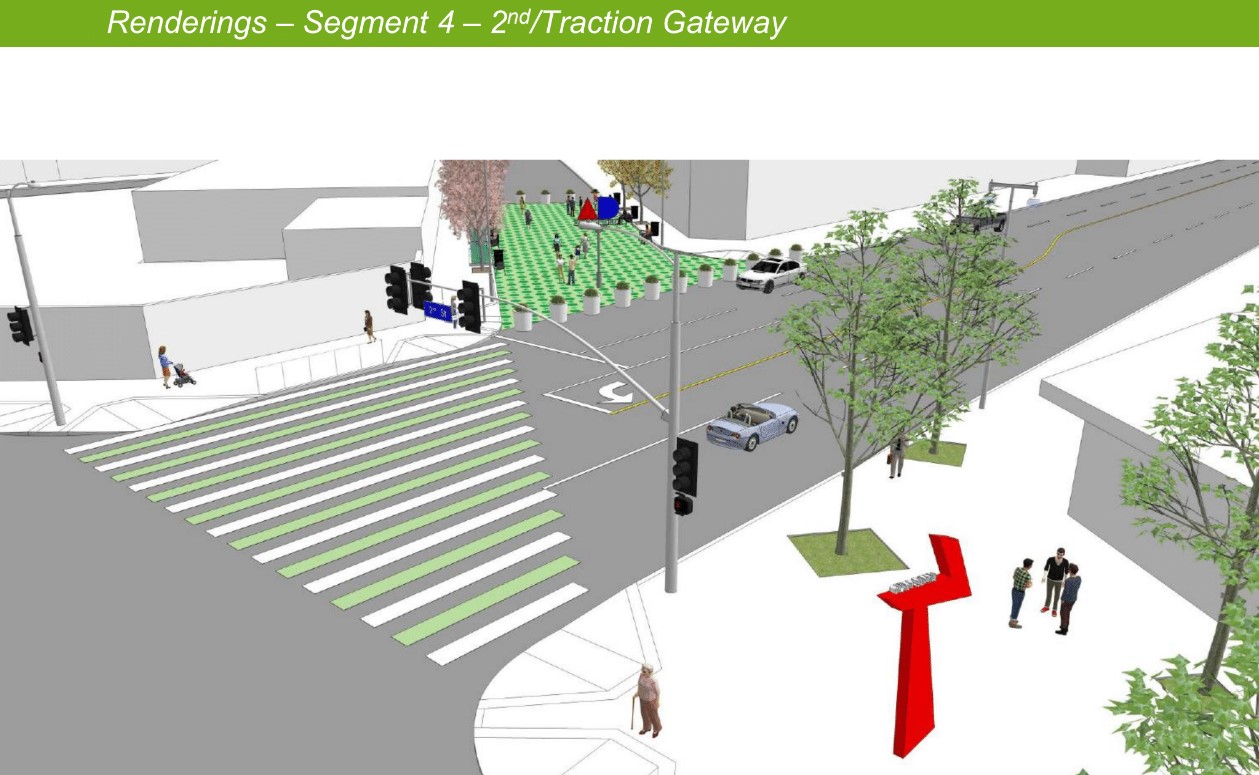Yesterday, livability advocates submitted a letter to Metro and L.A. City leadership urging Metro to promptly add several bike/walk facilities left out of Metro Regional Connector construction. The letter was signed by leaders of five community groups: BikeLA, Climate Resolve, MoveLA, Natural Resources Defense Council (NRDC), and Streets For All
"Transit works best when it serves and supports great places for people," noted Carter Rubin, Senior Transportation Lead at NRDC. "Finishing these important bike and pedestrian projects will ensure that downtown's neighborhoods are truly connected to the Regional Connector."
Last month, Streetsblog L.A. broke the story that during Regional Connector subway construction, Metro and the city Transportation Department (LADOT) omitted several bike and walk facilities, while widening streets and adding more lanes for drivers.
The missing Connector first/last mile facilities fall into two categories: (more on these below)
- omitted and scaled-back facilities in a Metro (with LADOT) federal grant - by Little Tokyo Station
- facilities omitted that had been approved in the city's Downtown Street Standards - at all three Connector stations
Streets For All founder Michael Schneider has been sounding an urgent note regarding the grant moneys, declaring that "[Metro and DOT] should implement the omitted elements now to avoid having to give the Feds their money back.”
Federal Grant Failures (see SBLA July 21 coverage)
In 2014, Metro received an $11.8 million federal grant for an expansive network of Little Tokyo Station bike/walk connections. Metro combined federal and local funds for the $29.7 million Eastside Access Improvements project.
Metro heavily scaled back the project scope, :
- 0.8 mile of new both-way protected bike lanes (1.6 lane-miles) became 0.6 mile of one-way protected bike lane westbound only - a 60 percent cut
- 1.8 new miles of unprotected lanes (some to be installed by LADOT) became 1.2 miles - a 33 percent cut
- A two block (1,500-foot) Alameda Esplanade bike path was trimmed to one (500-foot) block - a 66 percent cut
- One mile of bioswales was shortened to one-tenth of a mile (along the under-construction esplanade) - a 90 percent cut
- A People St plaza (on Traction Avenue between Alameda and Rose Streets) was omitted from the project

While some modest scope changes might be expected (often due to costs), Metro deeply slashed TIGER bikeways, omitting relatively low-cost items like unprotected bike lanes and a basic street closure plaza. For the ten-year two-billion-dollar connector construction, which was widening streets for drivers (see below) Metro shouldn't have needed to pinch pennies on accompanying bike/ped features.
Street Standards Failures (see SBLA June 21 coverage)
Metro implemented city street specifications for wider streets (adding more lanes for drivers) while ignoring those same city street specifications where they mandated narrower streets and bike facilities.
What follows may be a lengthy wonky technical point, but it highlights some failings at the crux of L.A. City's ongoing failures in implementing planned bike/walk/transit improvements. Advocates, led by Streets For All, are pushing to approve the Healthy Streets L.A. initiative which would force L.A. City to implement bike/walk/transit improvements approved in the city's Mobility Plan. The city, fearing being required to gradually implement its plan, recently went on the offensive to discredit the Mobility Plan. While continuing to rigorously enforce the Mobility Plan's street standards, city department leadership have discredited the Mobility Plan's bike/walk/transit networks as "aspirational guidance" with "no specific projects."
The city's street standards are basically the DNA for streets; they are very specific formulas for just how wide, how many lanes. The street standards mostly mandate wider streets with more lanes for cars, with no bike lanes appearing anywhere... anywhere except downtown Los Angeles.
Nearly all of L.A. City follows a very simple half-dozen-page street standard formula. But downtown is different. In 2009, the city adopted the Downtown Street Standards (later incorporated in the 2015 Mobility Plan). The downtown street standards specified preserving existing street widths (except for a few exceptions); their adoption ended nearly all street widening downtown. (L.A. is ending automatic spot widening elsewhere soon.) In some cases, the downtown standards specify narrowed streets, widened sidewalks, and added bike lanes.
Note that these downtown sidewalk and street widths - and bike lanes - are not the part of the (now being demoted to "aspirational") networks, they're part of the street standards - the DNA, the formula - the part of the city's plans that the city never questioned, and that the city had enforced rigorously, requiring projects to widen streets.
Street standards were enforced rigorously... until Regional Connector street restoration.
For rail and highway projects throughout L.A. County, when the local city street DNA says "widen," Metro does it without hesitation. In the case of the Regional Connector, where the DNA said "do not widen," Metro widened. Where the DNA said "add bike lanes," Metro ignored it.
For the Regional Connector, Metro widened various city streets, including parts of Alameda Street, 1st Street, 2nd Place, 2nd Street, Flower Street, Hope Street, and Temple Street.

Specifically, directly along stations, Metro widened:
- First Street at Little Tokyo Station - was 56 feet wide, Metro widened to ~64 feet. Street standards specify preserving the existing 56-foot width.
- Second Street at Broadway Station - was 43 feet wide, Metro widened to ~46 feet wide. Street standards specify narrowing this street to 42 feet wide.
- Flower Street (upper roadway) at Grand Station - was 33 feet, Metro widened to ~35 feet. Street standards specify preserving the existing 33 feet width.
Metro widened a bunch of streets it wasn't supposed to.
LADOT is not saying what their role was. At a minimum LADOT staff signed off on Metro's designs.
What's the problem with two-four-eight extra feet of roadway? Maybe that doesn't sound all that consequential, but it is extra distance and extra time where pedestrians are vulnerable while crossing streets. Wider street and wider lanes also encourage drivers to go faster.
And what did Metro put in the widened spaces? On rebuilt Connector streets, Metro did a combination of widened car lanes, new car lanes, new turn lanes/pockets, and even added a couple of on-street parking spaces. Metro added bike lanes on just two widened streets (1st and 2nd Streets - though only partially on 2nd where city plans specify two bike lanes, and Metro added a one-way westbound bike lane).
What next?
Metro made these mistakes in concrete. Metro should probably go back and redo the concrete curbs. That would be expensive, hence it is unlikely to happen.
Metro can partially remedy its missteps by re-striping streets, which would be relatively inexpensive.
In their letter, the advocacy groups urge Metro CEO Stephanie Wiggins and Metro Board Chair Mayor Karen Bass to "to move expediently to complete these required and promised pedestrian and bicycle improvements in the next three months before construction is closed out."
Adding the missing bikeways and pedestrian plaza would support Metro riders, and benefit the environment, public health, and the climate.
Metro should probably go further than the advocates demand for the basic bikeways approved many years ago. Downtown Regional Connector station areas deserve more car-free plaza spaces, curb-protected bike lanes, scramble crossings, road diets, slip lane removal, and more. But Metro and LADOT promptly making good on some of the approved walk/bike facilities could be an important down payment toward safe first/last mile station access.







